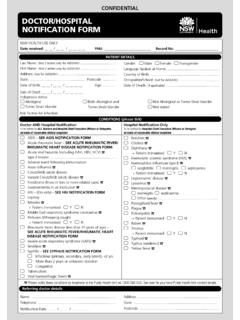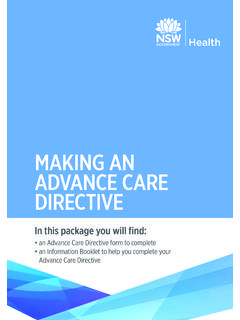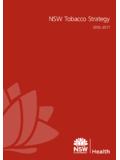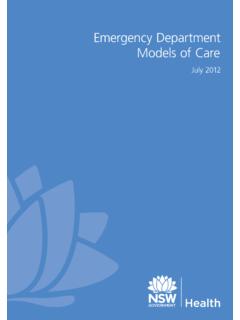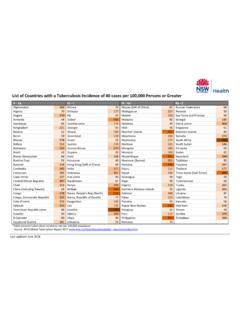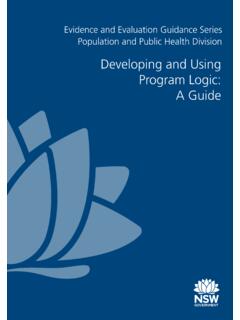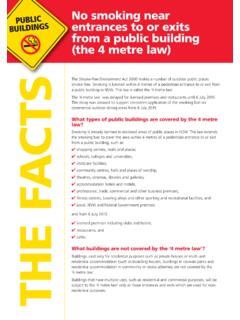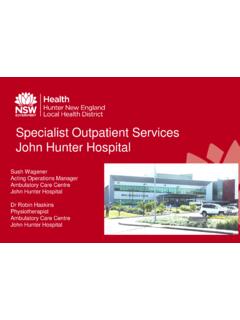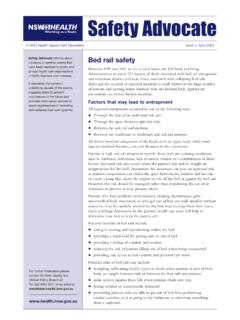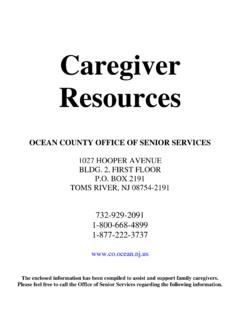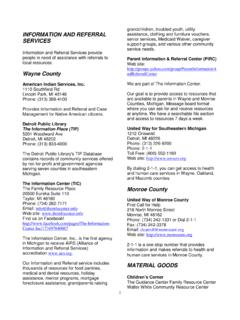Transcription of A Strategic Framework for Dental Health in NSW
1 Oral Health 2020: A Strategic Framework for Dental Health in NSWNSW MINISTRY OF Health 73 Miller Street NORTH SYDNEY NSW 2060 Tel. (02) 9391 9000 Fax. (02) 9391 9101 TTY. (02) 9391 9900 by: Centre for Oral Health Strategy NSWThis work is copyright. It may be reproduced in whole or in part for study or training purposes subject to the inclusion of an acknowledgement of the source. It may not be reproduced for commercial usage or sale. Reproduction for purposes other than those indicated above requires written permission from the NSW Ministry of Health . NSW Ministry of Health 2013 SHPN (CEE) 120487 ISBN 978 1 74187 883 7 Further copies of this document can be downloaded from the NSW Health website 2013 Oral Health 2020: A Strategic Framework for Dental Health in NSW NSW Health PAGe 1 Introduction ..2 Delivery of Oral Health Services in NSW ..2 Planning Context ..3 The Challenges Ahead.
2 3 The Oral Health of the NSW Population ..4 Goals ..7 Goal 1: Improve Access to Oral Health Services in NSW ..7 Goal 2: Reduce Disparities in the Oral Health Status of People in NSW ..8 Goal 3: Improve the Oral Health of the NSW Population through Primary Prevention ..9 Priority Populations ..10 Early Childhood ..10 Children and Adults with Special Needs ..10 Aboriginal and Torres Strait Islander People ..11 Older People ..11 Rural and Remote Communities ..11 Action Framework ..12 Primary Prevention ..12 Workforce ..15 Professional Education ..17 Data, Research and Evaluation ..19 Monitoring Progress ..20 References ..22 ContentsPAGe 2 NSW Health Oral Health 2020: A Strategic Framework for Dental Health in NSWOral Health 2020: A Strategic Framework for Dental Health in NSW (the Framework ) sets the platform for oral Health action in NSW into the next decade. It provides an overview of the oral Health status of the population, outlines the goals for oral Health services, describes target groups that require focussed efforts, and outlines the high level actions that will be pursued to improve the oral Health of the population.
3 The Framework will support the NSW Ministry of Health and Local Health Districts (LHDs) to plan and deliver priority programs tailored to the Health needs of the population at both a state and local level. It also acknowledges the significant role the Agency for Clinical Innovation (ACI), the Clinical Excellence Commission (CEC), the Health Education and Training Institute (HETI), and NSW Kids and Families will have in contributing to improved oral Health in NSW. Delivery of Oral Health Services in NSW Dental services, unlike other Health services, are not covered by the principle of universal access. In the Australian Health care system, Medicare and the entitlement that all Australians have to the medical and pharmaceutical benefits it provides are a well recognised strength. Public Dental services, however, are largely only provided to the young and the disadvantaged, with no Commonwealth scheme similar to Medicare that provides access to NSW, public Dental services are provided to children* and eligible adults, with the majority of Dental services being funded on a private basis.
4 For adults, this eligibility means they have one or more of the following cards: Commonwealth Seniors Health Card, Health Card, or Pensioner Concession Card. NSW Health does not charge a co-payment for oral Health services. The Commonwealth Government plays a role in the funding of Dental services, however, the NSW Government is responsible for delivering the major public program for children and eligible range of oral Health services provided through the NSW public Health system broadly includes Dental services to children and eligible adults according to criteria that prioritise emergency situations: those in most need and at highest risk of disease; Dental education and oral Health promotion services. Operationally in NSW these services are delivered by each of the Local Health Districts (LHDs). The services are delivered in Dental clinics based in community Health centres, hospitals and schools and include general dentistry such as examinations, fillings, and dentures.
5 Contracted services are also provided via the Oral Health Fee for Service Scheme (OHFFSS), which enables public oral Health services to provide care through a private practitioner using a voucher rural LHDs, clinics may be located in hospitals, schools, community Health facilities, or mobile Dental clinics. In some communities a private surgery may be rented to provide public sector oral Health services. In metropolitan areas, clinics are mainly located in community Health centres, or on school or hospital grounds. Eighteen Aboriginal Medical Services also provide Dental services funded by NSW Westmead Centre for Oral Health , the Children s Hospital at Westmead and the Sydney Dental Hospital provide general and specialist oral Health services in their clinics and through outreach programs in rural public Dental clinics. The specialist services include paediatric dentistry, oral surgery, endodontics, prosthodontics, special needs dentistry, oral medicine and oral pathology, orthodontics, and periodontics.
6 * This excludes access to general anaesthetics, for which there is eligibility criteria for children. IntroductionOral Health 2020: A Strategic Framework for Dental Health in NSW NSW Health PAGe 3 Planning ContextThere are a range of state and national oral Health programs, funding initiatives, reviews, and reports that have influenced this Framework . This includes input from the NSW Ministerial Taskforce on Dental Health , the report of the National Advisory Council on Dental Health established by the Commonwealth Government in 2011, and recently announced Commonwealth oral Health initiatives1 (including the Child Dental Benefits Schedule, National Partnership Agreements, and a Flexible Grants Program). Working with both the Commonwealth Government and private sector to provide enhanced oral Health services will be a key requirement into the future. There have also been significant reforms across the NSW Health system that have influenced this Framework : in particular, implementation of the National Health Reform Agreement.
7 Under the new governance arrangements, LHDs have clear responsibility and accountability for governing Health service delivery for their local district. These responsibilities and the funding required to deliver services to address local need are being articulated in a Service Agreement negotiated between the Ministry of Health , as purchaser and system manager/regulator, and the LHDs as providers of Health services. The Agency for Clinical Innovation (ACI) and the Health Education and Training Institute (HETI) will have an enhanced range of responsibilities and accountabilities. The Clinical Excellence Commission (CEC) and the Bureau of Health Information (BHI) are also taking on an expanded portfolio of responsibilities but largely within their current roles. Further, the statutory Health corporation, NSW Kids and Families has been established to champion the Health interests of children and young people whether they are at home, in the community or in or out of hospital.
8 This includes Health services for babies, children, adolescents, mothers, parents and families. These agencies are known as the "pillars . The Centre for Oral Health Strategy (COHS) NSW, which is part of the Population and Public Health Division within the Ministry, will need to ensure that there are strong linkages and partnerships with the Commonwealth, the private sector, the pillars (especially the ACI, HETI and NSW Kids and Families) as well as LHDs, and the Aboriginal Health and Medical Research Council (AH&MRC). The Challenges AheadSome of the challenges facing oral Health services over the next 10 years include:n Population growth: In 2026, the NSW population is projected to reach eight million; with Sydney remaining the dominant population centre in NSW. Most growth in Sydney will occur to the west and south west of the city. The population of most local government areas along the NSW coast is expected to increase, while the population of most inland areas of NSW is expected to These changing demographic patterns will influence the demand for services and will need to be considered in planning the location and type of services provided.
9 N Workforce: The majority of oral Health services are provided by the private sector, with a relatively small proportion of the oral Health workforce within the public sector. Attracting and retaining a skilled workforce, particularly in rural and remote areas and in specialist disciplines, is an ongoing and significant challenge. n Ageing of the population: In 2026, 20% of the population will be people aged 65 years and older, compared to in The prevalence of edentulism has decreased in older Australians, and accordingly, a range of chronic degenerative Dental disorders is now emerging (such as tooth wear, erosion, cuspal fractures, pulp infection, and root fracture). The consequences of increased tooth retention in older adults, combined with an increased proportion of clients in this age group with complex medical needs, means new skills will be required by dentists to manage these age-related disorders as well as an increased demand for more general, periodontic, and prosthodontic Dental 4 NSW Health Oral Health 2020: A Strategic Framework for Dental Health in NSWn Increasing demand for oral Health services: This is partly due to the ageing population, but also to changing public expectations, increasing services per visit required, and a greater dependence on the public sector as the number of private sector dentists in rural communities The impact of technology on access.
10 New information and communication technologies offer the potential to improve consumer access to Health information and services, as well as boosting operating efficiency this will require timely Unequal gains in oral Health status: There is a persistent gap between the most and least disadvantaged: for example healthcare cardholders, Aboriginal and Torres Strait Islanders, and people living in rural and remote communities. Focussed efforts will be required to ensure targeted service provision to those who are most in Balance between population prevention and individual treatment services: The cost of providing treatment continues to grow as does the demand for public Dental services. This demand for individual treatment will need to be balanced with the need to fund Health promotion and disease prevention initiatives. Opportunities to integrate oral Health within existing Health promotion programs in early childhood and chronic disease management need further exploration.
